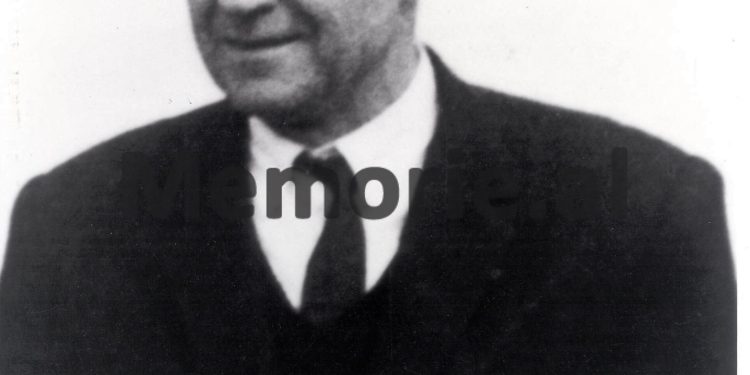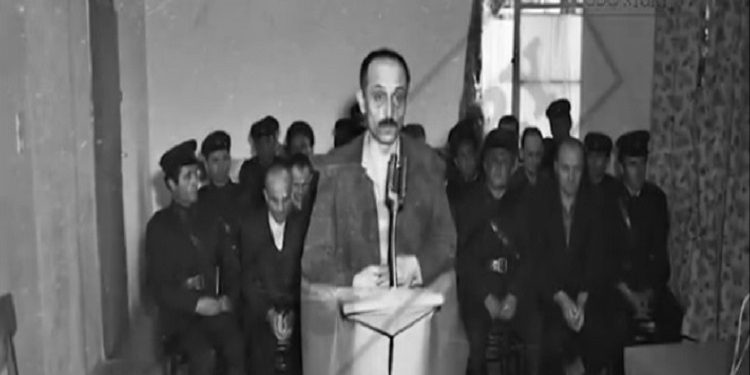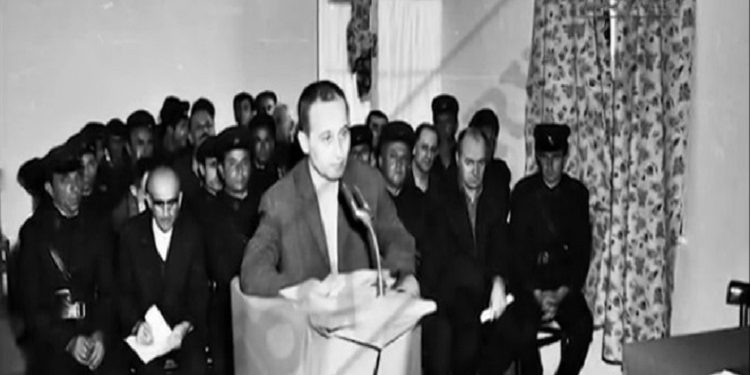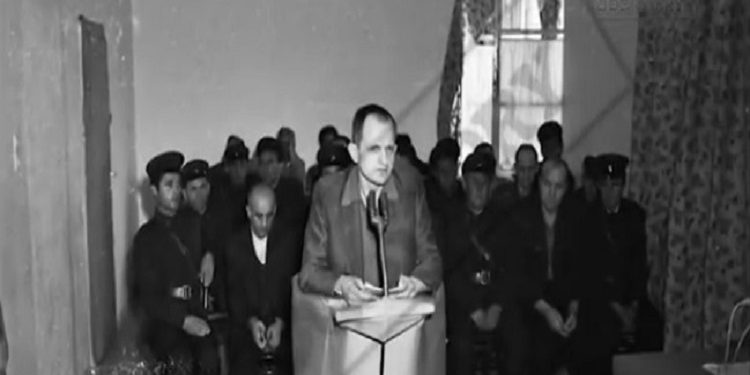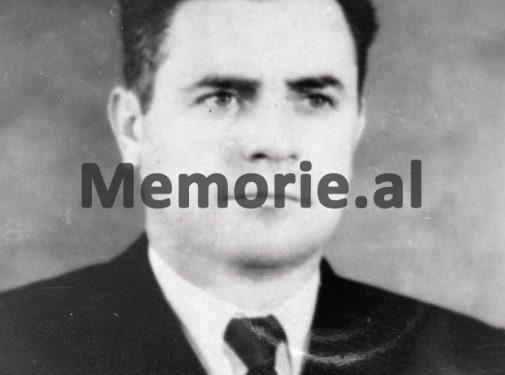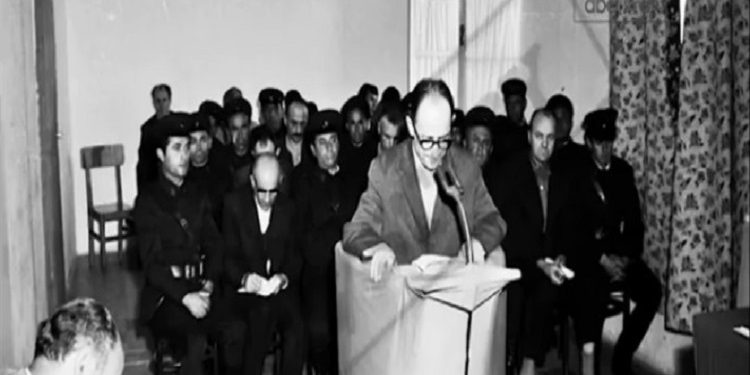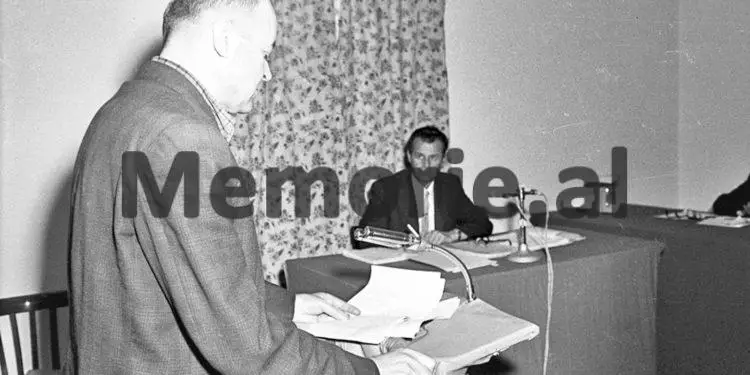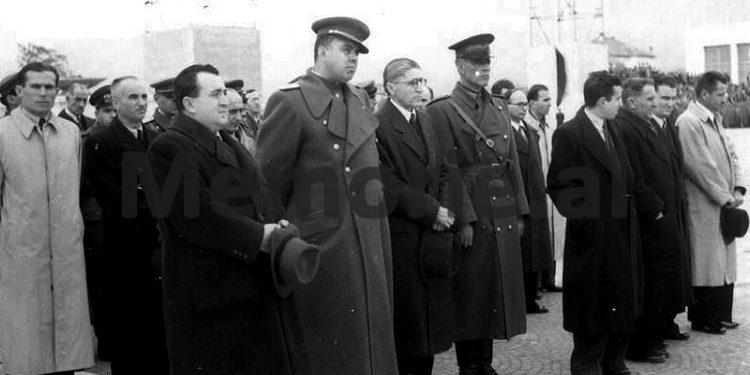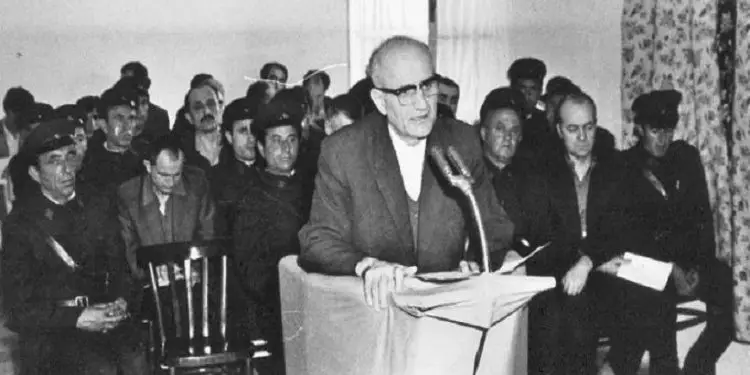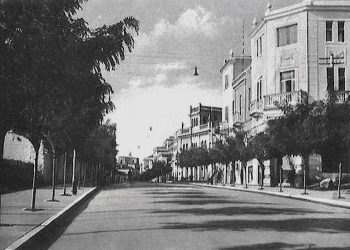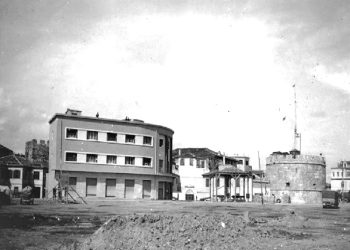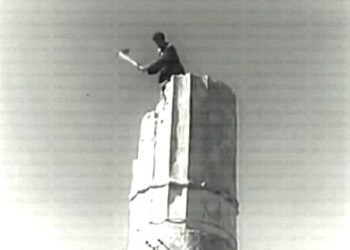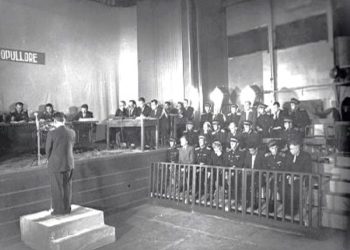By Ahmet Çollaku
Memorie.al / I were not lucky enough to work with the geologist Koço Plaku. When I first stepped into the seismic teams working in Albania, I first met the specialists Novruz Kodheli, Nikolin Leka, Siasi Koçiaj, who spelled out the names of geologists Koço Plaku and Henrik Veizi. Henrik used to communicate with Koço with friendly cartoons, with which we joked about big and small. The geologist Koço the Elder, had a passion for fishing, while Henrik, who was well suited to this fable, drew him talking and fighting with the fishes, competing to see who would come out stronger, so much so that Koço’s pants were torn in this fight…!
These cartoons circulated among the Albanian seismic teams as the most interesting news. The most beautiful ones were often displayed on socialist emulation signs, along with other company ordinances. Ah, there was a time when many things, good and bad, mingled! I rarely saw the geologist Koço Plaku, because my work was not related to him, I did not have any scientific topic. He was tall, solid, a little heavy at first sight.
When he was at the Oil Institute when he walked so aware, of his professional abilities, he appeared dignified sometimes outside and inside, through those dark and scary corridors like mining galleries of that ugly building. I remember that when I was a student in Romania, academician Murgeani, who taught the geology course, once told us that in Albania, there are two good geologists. One of these was the geologist Koço Plaku.
I also remember even better the time when he was picketed to punish him. One day I enter the office of the chief engineer of the company. Inside, near the table, Koço the Elder was sitting. He had his notepad open and was writing. That block was sacred. He did not speak, only wrote, with his head hanging over the notepad, he did not look at who entered or moved nearby. In that room, the silence was killing him that this situation of his, seemed to be foreseen by him, that it was a pre-imprisonment…! When I left the office, I noticed some people who were reluctant to enter that office.
While further, an officer of Fier’s Internal Branch caught my eye. I had seen him several times, dim and mean. He looked and listened. Later I heard that that sacred block, the State Security, had as evidence of Koço Plaku’s hostile work. Undoubtedly, that bloc will have had ideas for the future of Albanian oil. Yes, surprisingly, we Albanians always eat each other. We eat ourselves so much and we can’t get enough.
Here where I live now, among the books, I have an article by the geologist Koҫo Plaku, published years ago in an Albanian magazine, which my friend Fatmir Shehu sent me. In that article, geologist Koço Plaku writes about the “Diapir” of Dumre, about its geological-tectonic processes, and about the unusual prospect for oil. The “diapir” of Dumre is a halo with several sources, Kuçova, Pekishti, and many others not yet discovered. In a scheme-idea set in writing, geologist Koҫo Plaku, draws several anticlinal axes, positive elevation in limestone, many prospects for oil.
We Albanians are crazy, we shouldn’t have left Dumre! There is no end to Albanian stupidity! The late Koço, gave the perspective of the “Diapir” of Dumre in time. Wait, when this Albanian oil giant becomes a risk to foreigners, Pekishti becomes a risk to Tortonian and limestone, Galushi becomes a risk, for which I would give everything to drill the well as soon as possible, to risk Cërrik, or Paprri, for which I wandered for ten years…!
There are still dozens of Albanian geologists from the first generation that were not shot with bullets by the communism that went, yes, without telling me where they are? Where do they work and live? Does anyone care about them?! None!! Geologist Dhimitër Generali is a student of Koço Plaku, do you know anything about it?! No one knows anything! So, this geologist is also killed. This one was killed by the current democratic Albanian state itself, killed by this democratic and socialist government, with only one difference, the General was killed by indifference, by silence, by contempt.
This is how this beautiful country of mine is shot and killed every day! How many such geologists and geophysicists have been killed in Albania?! They don’t count! Look, every Albanian government kills its own geologists. There is a difference, those of communism hid from God, the latter democratic-socialists, they don’t hide from anyone, and they walk proudly together on the Boulevard “Dëshmorët e Kombit”. Reversible equation. Geologists and national assets are not reversible!
THE GEOLOGIST KOÇO PLAKU, IN THE MEMORIES OF PROF. DR. ALI MEMES.
In my memories, the geologist Koҫo Plaku remains the most affirmed specialist geologist of Albanian petroleum geology, a legend of our petroleum geology. His contribution is special in research, guidance, and in the discovery of oil resources. Geologist of great proportions, with deep insight and complete analysis of the formation of petroleum structures. He emphasized the special role that flysch plays on limestones, not only as a cover. I am mentioning some powerful ideas of this great Albanian geologist, with whom I had the good fortune to personally do some study topics.
As authors, we were following the drilling of the “Amonica-7” well, which later revealed the source of ammonia. Before the well encountered the limestones we determined that the flysch dip angles were of concern, which meant that the limestones would be encountered deeper than 2500m. Koçua told us competently; don’t believe the large dip angles of the flysch, when the well gets closer to the transient package, you will see that the dip angles will decrease significantly. This statement turned out to be true not only in the “Am-7” well, but also in many wells of this source-site.
What did the geologist Koço Plaku confirm? He explained that the wrinkle-forming forces have a sense of direction from east to west, that flysch, as a more plastic mass compared to limestone, has also been subjected to these forces (in conditions of high temperature and pressure, where, as evidenced, sands pass up to liquefaction). So the flysh, Koçua asserted, is squeezed like a rope, on the one hand the flysh is pushed from east to west, and on the other hand it is obstructed by the peak of the limestone rise, therefore it (the flysh) forms numerous harmonics (garmoshka – said in Russian according to Slopes with excessively large angles of descent that can disorient someone.
Such flysch phenomena have been noticed not only in Amonica, but also in many other regions. I mention Mollaj here, the well with the Vjosa-2 fountain (author Lili Thomai and Ali Mema) where the angles of fall in the flysch worried us, but near the limestone they decreased excessively. Koço Plaku insisted to us not to be scared by the powerful deposits of the upper floor because there are washes below them and the limestones are not deep. In this way, he increased the optimism for research even in areas with new covers on the surface.
The geologist Koҫo Plaku highly valued seismic as a capital study method, which determines the morphology in depth. This was the reason he often came to my office at the Petroleum Institute in Fier in the years 1970-1974, urging me to speed up the construction of seismic structural schemes. Koçua said things have meaning in time and they should be appreciated.
The dictatorship started to bring great worries to Koço. I remember one day when he told me that in 1957, (after the departure of brother Panajoti from Albania), I would have killed myself, but the discovery of the source of Gorishti saved my life. The great assessment of seismic by Koçua as well as the fact that in the seismic authors I and Wilson Bare, we correlated a seismic loop, a phenomenon which at that time was unknown, led us to the wrong design of the “Rabie-4” well, where the main author was Koço Plaku.
So even geniuses make mistakes, but this in no way obscures the special contribution of the geologist Koҫo Plaku, as the discoverer of several sources, namely Ballsh, Visoka, Gorrishti and so on, and as an exponent of many powerful geological ideas in oil research Albanian.
The geologist Koço Plaku highly valued factual data, especially those of drilled wells. He often told the fable; “the well is qitap, which bothers not only my mustache but also Kadi’s”. I mention here the geological profile of the wells “Fitore-5”, “Fitore-6” and “Fitore-3”, in the area of Saranda. The last two wells had captured the limestones of the southern extension, of the Ftterra range. To the west of “Fi-6”, it was designed by specialists Dhimiter Stefa and Ali Mema, the other well “Fi-5” with the task of discovering a new object, divides the overlap of the southern range of Fterra, so to the west of “Fi- 6”. The “Fi-5” well went to the western side of “Fi-6” up to 2100 m. did not meet the expected object.
Under these conditions, at the meeting of the Directorate of the Petroleum Institute, it was decided to stop drilling the well. At that time, an employee of the drilling brigade had an accident and died in this well. The situation became serious. In that meeting, which was to be decided on the well, Henriko Veizi entered first, followed by me as the author of the well. On the other side of the T table, Koço Plaku took a seat, which walked in stooped because he was suffering from sciatica. Henriku, as soon as he saw Koçon walking bent over in the direction of director Beqir Ali, said to the latter; he served before his superior and the difficult situation was somehow calmed down by Henrik’s fine humor. Only he knew how to defuse tense situations.
The former head of the sector, Protoko Murataj, thought that the “Fi-5” well should be deepened to catch the object, while Koço Plaku, the former chief of the cabinet told Protoko; “Aren’t three wells in a line enough to stop drilling, or should we make a channel for you?” For Koço Plaku, three wells in a row were more than one qitap. The well stopped drilling. Koço Plaku and Henrik Veizi were colleagues and close friends, Koço really liked Henrik’s cartoons, especially those where he drew Koço the hunter, with boots hunting ducks.
Koçua knew well the mechanism of the formation of structures in limestone, therefore, for this; he held fierce debates in the Scientific Council of the Petroleum Institute in Fier. In that period, some specialists of the Institute supported the idea that the limestone structures in depth do not have faults on the western side, that the limestones present anticlines and synclines as a continuation of each other, with a tendency for the anti-clinal to overlap a part of the syncline. While Koçua insisted that this is not the feature of our limestone structures.
He said that the limestones are not rubber to create such wrinkles; as a result of overstepping they suffer large tectonic breaks in the western flank with amplitude of 1.5 – 2 km. This is the tectonic style of our structures, another contribution of the colossus Koço Plaku, in Albanian oil research.
In 1974, before the arrest of specialists Koço Plaku, Milto Gjikopulli, Protoko Murataj and Beqir Alia, the Fier Party Committee organized a large meeting at the Oil Institute in Fier to “harvest” the aforementioned geologists. The great theoretical, practical and scientific contribution of the geologist Koço Plaku made the specialists; Ali Mema, Telo Velaj and Hasan Bakia, gave him the highest ratings in that meeting, risking them, because they were dancing in an extremely mined field.
The communist dictatorship “decorated” the geologist Koço Plaku with a bullet in the forehead. He did the same with the geologist Milto Gjikopulli. But the bitter legend does not end here; they were not even given graves. This is how communism buried Albanian geologists, away from people, in dark nights, in some pits, hidden even from God. Maybe this is the first case! The dictatorship had killed in time, a foreign scientist working in Albania, a friend of Albania, the Polish scientist, Stanislav Zuber. Now wasn’t it the same thing?! Memorie.al




